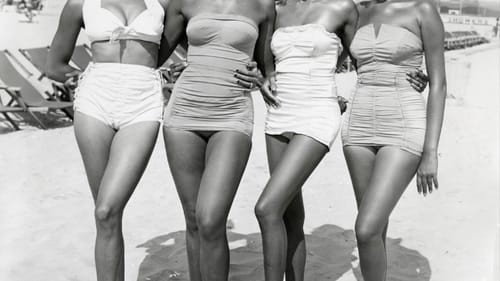Stay in the Loop
BSR publishes on a weekly schedule, with an email newsletter every Wednesday and Thursday morning. There’s no paywall, and subscribing is always free.
Beautiful humanity
The Delaware Art Museum presents ‘Posing Beauty in African American Culture’

The Delaware Art Museum sits on a gently winding road in a picturesque residential neighborhood near the northwest outskirts of Wilmington. Signage in its main hallway, leading to the photography exhibition Posing Beauty in African American Culture, reads “this is your museum.”
It’s an apt sentiment for the show in a city that, like Philadelphia, has a majority of Black residents (making up 57 percent of Wilmington’s population). Organized by artist and scholar Deborah Willis and curated by Heather Coyle, Posing Beauty seems particularly suited to connect with the public.
Beauties and stories
The show’s space is pleasingly packed. Each piece definitely has its own area, but each wall is an eyeful. The centerpiece is a full wall titled Posing Beauty by Hank Williams Thomas. There are three large portraits of ‘70s-era advertisement photographs completely surrounded by Jet Beauties of the Week, which span decades. A multitude of bikini-clad women pose invitingly, but I was struck by how prim they look by today’s standards, where this type of photography frequently features spread legs and arched backs. Many of Posing Beauty’s swimsuits basically amount to a halter and shorts. The collage is a slightly titillating display of the female form in its full beautiful humanity.
This show reaches for a gold standard in its inclusion and complexity, with various images of queer beauty at several points in the show. There are images of everyday people adorning themselves and stepping out. One striking period photograph features a pretty waitress in the foreground while an elegantly dressed woman is shadowed in the background—engaging us and telling a story, like the best photography does.

Famous faces
Along with commonplace expressions of beauty, there are images of famous faces. A large picture of Michelle Obama sits beside an atypical image of Serena Williams with a bump and curl. It seemed a missed opportunity not to juxtapose Williams’s childhood aesthetic of intricate African braids and beads with her contemporary look, which features flowing (and often blond) weaves and wigs. Some walls do seem to have a more coherent and pointed message, like the one that progresses from an excerpt of Tony Morrison’s The Bluest Eye to a Black woman switching out her afro and brown eyes for flowing blond tresses and blue contacts. Beside this image, there’s a performance shot of rapper Lil’ Kim.
Vision of inclusion
The show overall doesn’t seem to offer a cohesive message. Instead, viewers are invited to bring their own eye for interpretation. I especially enjoyed Omar Victor Diop’s large portraits of himself and another model posing as historical figures, and a wall of striking contemporary editorial photos featuring Lola Flash, a photographer who interrogates race, sexuality, and gender. Perhaps my favorite single piece was Lauren Kelley’s Pickin, depicting a woman with an afro made of butterscotch-colored afro picks against a red background.
Community members who wrote the labels for many of the pieces on display make a unique feature of this exhibition, part of the museum’s “strategic vision of inclusion and deep community engagement.” Curatorially, this also means seeking out the work of women and artists of color to collect and display. All of this is admirable, but ultimately real success in this type of inclusion requires a commitment to racial parity among the salaried decision-makers and researchers on staff, in addition to these other outreach initiatives. I hope that gets folded into the plan, if it isn’t already.

When you can’t rely on school
Artwork labels provided by the museum aimed to be short and informational, but weren’t always correct. One of the notable faces in the exhibit is famed revolutionary and Pan-Africanist Kwame Ture. He’s certainly not a household name for most Americans, but for those of us who actively study the African diaspora, he’s a prominent figure. The write-up for his image stated that he was born Kwame Ture and later changed his name to Stokely Carmichael. Those who know of him will immediately realize that this statement is backward. I pointed this out to Coyle, on hand for my tour, who good-naturedly assured me that the change would be made.
It seems like a small thing, but when I think about my own work to educate myself about the history of Black people, and how I couldn’t rely on the free and compulsory education of primary and secondary school in this arena, I realize just how essential other institutions of learning were in my knowledge of self. On the trip home, I pondered how many of that aforementioned 57 percent would have the necessary context to know Kwame Ture was born Stokely Carmicheal, and not the other way around—or at least had the personal investment to quadruple-check that the information was correct before inadvertently adding to the glut of misinformation about Black history in America.
But overall, Posing Beauty and the other exhibits available at the Delaware Museum of Art are well worth a gander. It’s a beautiful space, with a very friendly and accommodating staff.
What, When, Where
Posing Beauty in African American Culture. Through January 26, 2020 at the Delaware Art Museum, 2301 Kentmere Parkway, Wilmington, DE. (302) 571-9590 or delart.org.
Delaware Art Museum facilities, entrances, galleries, and parking are all easily wheelchair-accessible, and there are wheelchairs available to borrow at no cost. Visit online for more information on accessibility.
Sign up for our newsletter
All of the week's new articles, all in one place. Sign up for the free weekly BSR newsletters, and don't miss a conversation.

 Crystal Sparrow
Crystal Sparrow